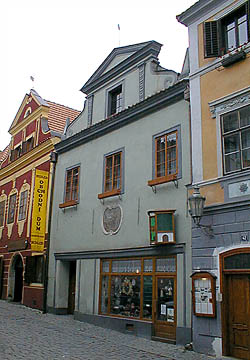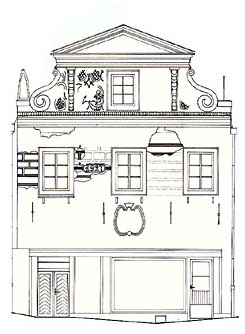Soukenická No. 41
 Location:
Location:
Soukenická No. 41
Description of the Building:
A one-storey row house with a saddle roof , perpendicular to the street. The street facade is divided by three axis, an early-Baroque gable with obelisks, volutes and pilasters articulated by decorations in the shape of coins, is finished by a triangle gable post. The ground floor layout - a two-aisle disposition, in the rear section of the house there is a mezzanine.
Architectural and Historical Development:
The house is of medieval origin according to the character of cellars, originally shorter than today. The vaults on the ground floor and the hall on the first floor originate from the Rennaissance and early Baroque period: in the upper room a joisted ceiling with a girder with plaits was discovered, possibly of Rennaissance origin. Later division walls were built on the ground and first floors. The most significant change was probably the setting of a new staircase in the left front ground floor section. At present a renovation of the pre-war portal was made and some of the formerly set division walls were removed.
Development of facade:
There were no findings from the Middle Ages and Renaissance period. In the early-Baroque period, around the half-17th century the present gable was probably built. It is articulated with two pilasters and volutes, obelisks all over the sides finished in a triangle-shape extension. The facade below the gable was articulated with the corner rustic-work at different length, its oldest discovered coloured articulation: white-and-grey, l ater light grey-and-grey, green-and-grey.

|

|
In 1927 the facade was adapted in a historical way (Baroque and Renaissance decorative motives), with painted light grey-coloured ornaments and ashlar rustic-work set against the red colour. In 1938 the above door-step ledge unified a shop window and an entrance into the shop. After the facade restoration, in 1993, the building was covered in silicate green-and-grey-coloured paint. The historical coloured scheme was not fixed during the restoration work.
Significant Architectural Features:
- plastic articulation of the facade as a whole
- a joist ceiling with a girder on the first floor
- a receeding stucco field of the vault in the left front section on the ground floor
- a mural on the facade, without further characteristics
- a historic collar beam roof truss in the front section of the house removed during the building of the attic
 History of the House Residents:
History of the House Residents:
The first owner of the house was a maltster Toman Husků, mentioned in 1572. Before 1600 Jan Nigrin lived there, followed by Ondřej Pankl - the house was declared a brewery and it belonged to the Pankls to 1634, when Ondřej Klein came there. After him Anna Klein, married to Mathäser von der Grün from České Budějovice, looked after the house. In 1636 Zachariáš Fleischanderle became the owner of the house and five years later Ambrož Terwald, a royal maltster from Černá v Pošumaví. In the years 1657 - 1687 a royal head scribe Tomáš Ignác Netolický came there and from 1689 Zuzana Netolická kept the house. Afterwards the house was obtained by a royal apothecary Jan Debussi and from 1698 a town scribe František Antonín Littera stayed there. In the years 1753 - 1786 the house belonged to Jan Russ, an organ player at St. Viitus church, followed by a dress-maker\'s apprentice Jan Schimack. At the beginning of the 19th century the owners changed very rapicly. Among those worth mentioning is Bernard Walzel, who lived in the house from 1817 to 1832.
Present Use:
Hotel Seneca

